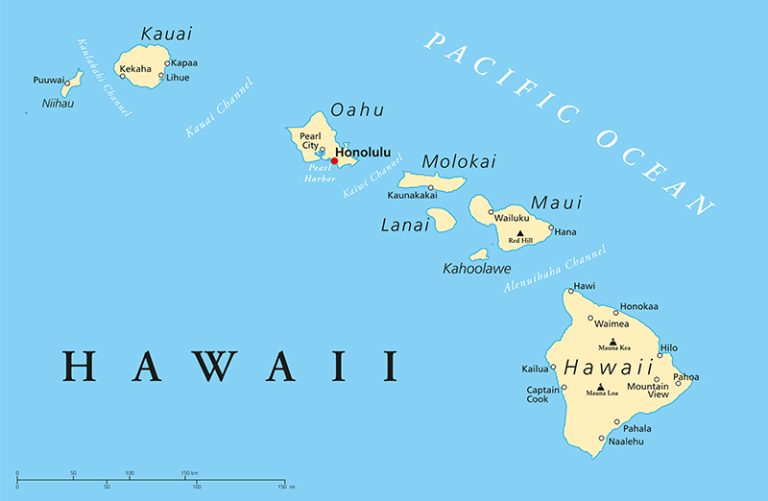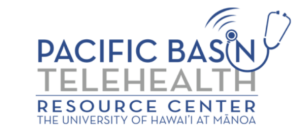Hawaiʻi Resources
An overview of telehealth resources available in Hawaiʻi
Region Overview
Hawai‘i is considered the most isolated population center in the world. It is 2,390 miles from California and 3,850 miles from Japan. This geographic isolation and the geographic make-up of the state present challenges that can be mitigated by telehealth.

While 90% of the state is considered rural, the state’s health care system is concentrated in the 10% that is not. For example, all tertiary health care facilities are located in Honolulu on the island of O‘ahu which means rural populations have to travel to Honolulu to receive any form of specialty care.
In addition, there is also a critical shortage of primary care providers on the neighboring islands. This presents a challenge to anyone living in neighboring islands who must travel by air. For some, this could be a significant financial burden that could easily be remedied by telehealth.
Health Ecosystem
Special Populations
There are several special populations in the State of Hawai‘i that have access to care issues. High-risk pregnant women are examples of patients who need to travel from the neighboring islands to Honolulu to receive necessary health care. There is only one Level 3 Mother-Baby hospital in the State of Hawai‘i that is open to all pregnant patients regardless of health plan, ability to pay, and gestational age. The other hospitals on the neighbor islands do not have Neonatal Intensive Care Units (NICUs) to provide care for any premature babies delivered prior to 36 weeks’ gestational age. High-risk pregnant women must therefore travel often to Oʻahu to receive perinatal care services. In addition, the providers on the neighbor islands also struggle to access essential fetal imaging and prenatal diagnostic testing for their patients. Annually 5,000 pregnant women fly from our neighbor islands to Oʻahu for prenatal ultrasound screening for abnormalities that could potentially result in morbidity and mortality. Of which, 100 women are emergency flight transported to O‘ahu (average cost of $10,000- $15,000 per transport). This is a high-risk group that could greatly benefit from telehealth networks and technology that would remove the need to travel and other barriers in receiving the care they need for healthy pregnancies.
Native Hawaiians and Pacific Islanders are one of our special populations that are also the fastest growing populations in the US. In Hawai‘i, they makeup 10.1% of the total population. They disproportionately experience greater health disparities that lead to worse health outcomes. In 2015, Native Hawaiians and other Pacific Islanders significantly lead other race/ethnicities in mortality rates across many indicators. They had the highest mortality rates for all-cause, asthma, breast cancer, cirrhosis, colon cancer, lung cancer, oropharyngeal cancer, prostate cancer, drownings, fall-related injury, and across all age groups. In addition, no other ethnic group has been impacted by COVID-19 more than Pacific Islanders. They account for a plurality of COVID-19 cases (30%) in Hawai‘i despite making up only 4% of the population. Native Hawaiians are third with 17% of COVID-19 cases.
Further, Hawai‘i’s disability community is at a distinct health care access and technological disadvantage. Approximately 62% of adults with a disability own a desktop or laptop computer, compared with 81% of those without a disability. The affordability of devices and connectivity and lack of access to training is only compounded by the need for assistive and adaptive technology. Hawai‘i’s disability community has traditionally been underserved in the area of technical assistance for digital literacy and telehealth. This is a priority special needs community of focus for PBTRC.
Much of the Hawai‘is population enjoys digital literacy and often takes for granted everyday occurrences like video calling. Access to broadband is increasingly seen as essential and addressing digital inequity is the next step to ensuring all of Hawaii’s underserved disability population is receiving the same access that others consider commonplace.
Broadband infrastructure, broadband access, and digital literacy has been around for a long time. But now, low-income populations who already face barriers with access to care are even more disadvantaged because of the inability to connect to telehealth services. Whether it be the lack of adequate speed, inadequate devices, or lack of knowledge on how to use devices and applications, these unmet health needs must be addressed in conjunction with telehealth.
PBTRC works in collaboration with partners to understand the current needs and technical assistance demands from the community. We will work with various communities to plan for increased “access” to broadband and telehealth access points. PBTRC also recognizes the need for “digital literacy” or “know-how” to use technology effectively for telehealth for patients and families. Telehealth services in Hawai‘i have moved significantly to patients in their homes using their own devices. Based on provider surveys from Hawai‘i Medicaid Managed Care Organizations and the Hawai‘i Primary Care Association that serves our Federally Qualified Health Centers (FQHCs), “digital equity and access” and “digital literacy” are top challenges for health care providers serving our most rural and vulnerable communities.
Telehealth Readiness
At the start of the COVID-19 pandemic,Hawai‘i Emergency Management Agency (HI-EMA) conducted a needs assessment survey to understand current telemedicine capacity across the state of Hawai‘i, determine readiness to increase that capacity, identify gaps for planning purposes, and measure telemedicine utilization pre- and post-COVID-19 public health emergency. The report, entitled “2020 Hawai‘i Emergency Management Agency (HI-EMA) State Emergency Support Function #8 (SESF #8) Statewide Telemedicine Needs Assessment (PDF),” provided a snap-shot of the various telehealth platforms used across the state and the overall sufficient broadband in urban areas but significant challenges with broadband connectivity in rural and underserved areas.
In 2021, the State of Hawai‘i Department of Labor and Industrial Relations Workforce study on Digital Literacy and Readiness to measure Hawai‘i residents’ readiness for a digital economy and their relative digital literacy. The report is very comprehensive and found varying levels of digital readiness groups in Hawai‘i that fall in a continuum of readiness from relatively more ready to relatively unprepared. The report states that in Hawaiʻi, “the less ready accounted for only 19% whereas the more ready amount to 81%, Hawai‘i seems to have a higher than national level of digitally unprepared residents.” The good news is that our State has prioritized digital literacy and access. PBTRC is actively involved in such projects.
Telehealth Initiatives
Telehealth provides a viable solution for overcoming many of the challenges for the region’s remote communities. Hawaiʻi’s telehealth adoption increased from 2% in 2014 to 20.5% in 2019 (Reports to the 2015 and 2020 Legislature, Sub: Report on Findings from the Hawaiʻi Physician Workforce Assessment), with a majority of providers in Hawai‘i now adopting telehealth in response to COVID-19 measures.
The University of Hawaiʻi through the PBTRC has served the Pacific Region for the last ten years and has a strong track record in working collaboratively with health care providers and systems in the region. PBTRC convenes a telehealth “Hui” (“group” in Hawaiian) of stakeholders to track telehealth needs, resources, and developments. PBTRC also participates in the Broadband Hui as telecommunication infrastructure is a major barrier for telehealth in the region.
